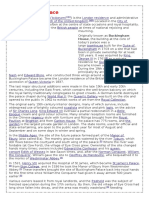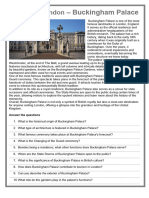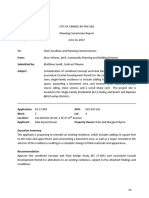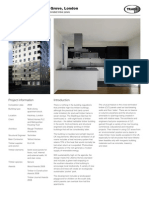0 ratings0% found this document useful (0 votes)
20 viewsBpalace: Buckingham Palaceis The
Bpalace: Buckingham Palaceis The
Uploaded by
Sebastian AlupoaeiBuckingham Palace is the London residence and administrative headquarters of the British monarch. Originally constructed in 1703 as a large townhouse, it was acquired by King George III and expanded over the 19th century. Today, Buckingham Palace serves as a working building and center of Britain's constitutional monarchy, hosting royal events and ceremonies. The famous balcony is used to mark important national occasions like Trooping the Colour and royal weddings.
Copyright:
© All Rights Reserved
Available Formats
Download as DOCX, PDF, TXT or read online from Scribd
Bpalace: Buckingham Palaceis The
Bpalace: Buckingham Palaceis The
Uploaded by
Sebastian Alupoaei0 ratings0% found this document useful (0 votes)
20 views1 pageBuckingham Palace is the London residence and administrative headquarters of the British monarch. Originally constructed in 1703 as a large townhouse, it was acquired by King George III and expanded over the 19th century. Today, Buckingham Palace serves as a working building and center of Britain's constitutional monarchy, hosting royal events and ceremonies. The famous balcony is used to mark important national occasions like Trooping the Colour and royal weddings.
Original Title
Engleza Palace
Copyright
© © All Rights Reserved
Available Formats
DOCX, PDF, TXT or read online from Scribd
Share this document
Did you find this document useful?
Is this content inappropriate?
Buckingham Palace is the London residence and administrative headquarters of the British monarch. Originally constructed in 1703 as a large townhouse, it was acquired by King George III and expanded over the 19th century. Today, Buckingham Palace serves as a working building and center of Britain's constitutional monarchy, hosting royal events and ceremonies. The famous balcony is used to mark important national occasions like Trooping the Colour and royal weddings.
Copyright:
© All Rights Reserved
Available Formats
Download as DOCX, PDF, TXT or read online from Scribd
Download as docx, pdf, or txt
0 ratings0% found this document useful (0 votes)
20 views1 pageBpalace: Buckingham Palaceis The
Bpalace: Buckingham Palaceis The
Uploaded by
Sebastian AlupoaeiBuckingham Palace is the London residence and administrative headquarters of the British monarch. Originally constructed in 1703 as a large townhouse, it was acquired by King George III and expanded over the 19th century. Today, Buckingham Palace serves as a working building and center of Britain's constitutional monarchy, hosting royal events and ceremonies. The famous balcony is used to mark important national occasions like Trooping the Colour and royal weddings.
Copyright:
© All Rights Reserved
Available Formats
Download as DOCX, PDF, TXT or read online from Scribd
Download as docx, pdf, or txt
You are on page 1of 1
BPalace
Buckingham Palaceis the London residence and administrative headquarters of
the monarch of the United Kingdom. Located in the City of Westminster, the palace is
often at the centre of state occasions and royal hospitality. It has been a focal point
for the British people at times of national rejoicing and mourning.
Originally known as Buckingham House, the building at the core of today's palace
was a large townhouse built for the Duke of Buckingham in 1703 on a site that had
been in private ownership for at least 150 years. It was acquired by King George III in
1761 as a private residence for Queen Charlotte and became known as The Queen's
House. During the 19th century it was enlarged, principally by architects John
Nash and Edward Blore, who constructed three wings around a central courtyard.
Buckingham Palace became the London residence of the British monarch on the
accession of Queen Victoria in 1837.
The last major structural additions were made in the late 19th and early 20th
centuries, including the East Front, which contains the well-known balcony on which
the royal family traditionally congregates to greet crowds. A German bomb destroyed
the palace chapel during World War II; the Queen's Gallery was built on the site and
opened to the public in 1962 to exhibit works of art from the Royal Collection.
The original early 19th-century interior designs, many of which survive, include
widespread use of brightly coloured scagliola and blue and pink lapis, on the advice
of Sir Charles Long. King Edward VII oversaw a partial redecoration in a Belle
Époque cream and gold colour scheme. Many smaller reception rooms are furnished
in the Chinese regency style with furniture and fittings brought from the Royal
Pavilion at Brighton and from Carlton House. The palace has 775 rooms, and the
garden is the largest private garden in London. The state rooms, used for official and
state entertaining, are open to the public each year for most of August and
September and on some days in winter and spring.
Today, Buckingham Palace is very much a working building and the centrepiece
of the UK’s constitutional monarchy, serving as the venue for many royal events
and ceremonies from entertaining foreign Head of States to celebrating
achievement at Investitures and receptions. More than 50,000 people visit the
Palace each year as guests to State banquets, lunches, dinners, receptions and
Garden Parties. Her Majesty also holds weekly audiences with the Prime
Minister and receives newly-appointed foreign Ambassadors at Buckingham
Palace. The balcony of Buckingham Palace is one of the most famous in the
world. The first recorded Royal balcony appearance took place in 1851, when
Queen Victoria stepped onto it during celebrations for the opening of the Great
Exhibition. Since then, Royal Balcony appearances have marked
many occasions from The Queen’s annual official birthday celebrations to watch
the RAF Flypast at the end of Trooping the Colour, Royal Weddings, as well as
special events of national significance such as the 75th anniversary of the Battle
of Britain.
You might also like
- Atestat Engleza - Buckingham PalaceDocument31 pagesAtestat Engleza - Buckingham PalaceDorina Călin100% (1)
- Sample For A Design ProposalDocument7 pagesSample For A Design ProposalSuresh Gunasekara100% (2)
- National Building Code of The Philippines Chapter XI-XIII SummaryDocument3 pagesNational Building Code of The Philippines Chapter XI-XIII SummaryJoshua CimanesNo ratings yet
- DIY WorkbenchDocument2 pagesDIY Workbenchdnaman100% (2)
- Palace: Buckingham Palaceis TheDocument1 pagePalace: Buckingham Palaceis TheSebastian AlupoaeiNo ratings yet
- Buckingham PalaceDocument1 pageBuckingham PalacesepsepNo ratings yet
- Palatul BDocument3 pagesPalatul BCiulean NicuNo ratings yet
- Buckingham Palace HistoryDocument1 pageBuckingham Palace HistoryDoctor StrangeNo ratings yet
- Buckingham PalaceDocument25 pagesBuckingham PalaceMihaela Monica MotorcaNo ratings yet
- Buckingham PalaceDocument1 pageBuckingham PalaceMaxim SuhanNo ratings yet
- Borough Market Is One of LondonDocument2 pagesBorough Market Is One of Londonn.t.nhan2405No ratings yet
- Buckingham PalaceDocument3 pagesBuckingham PalaceMateo TibinacNo ratings yet
- History of Buckingham PalaceDocument5 pagesHistory of Buckingham PalaceMarina AdrianNo ratings yet
- Buckingham Palace Fact SheetDocument4 pagesBuckingham Palace Fact SheetSwethaNo ratings yet
- BuckinghamDocument2 pagesBuckinghamKlejdiNo ratings yet
- ApuntesDocument1 pageApuntesadelacarocontreras06No ratings yet
- Buckingham PalaceDocument2 pagesBuckingham PalaceKlejdiNo ratings yet
- The Royal Collection © 2004, Her Majesty Queen Elizabeth IIDocument7 pagesThe Royal Collection © 2004, Her Majesty Queen Elizabeth IINicoleta DogaruNo ratings yet
- UK Bucking Ham PalaceDocument10 pagesUK Bucking Ham PalaceAriel AbisNo ratings yet
- Andra LesDocument2 pagesAndra LesMihaela CopilNo ratings yet
- Who Lives in Buckingham Palace Today?Document3 pagesWho Lives in Buckingham Palace Today?Valentina CnNo ratings yet
- Can You Name Any Place in Great Britain Which Is Internationally Known? What Is It Noted For?Document1 pageCan You Name Any Place in Great Britain Which Is Internationally Known? What Is It Noted For?Lina BestNo ratings yet
- Buckingham Palace TodayDocument5 pagesBuckingham Palace TodayMARIA PANĂNo ratings yet
- The Royal Residences in Great BritainDocument12 pagesThe Royal Residences in Great BritainDana TanasescuNo ratings yet
- British CastlesDocument2 pagesBritish CastlesYourGoddessNo ratings yet
- LondonDocument5 pagesLondonskander sekriNo ratings yet
- Buckingham PalaceDocument15 pagesBuckingham PalaceИнна КостюкNo ratings yet
- Buckingham Palace As Historical PlaceDocument2 pagesBuckingham Palace As Historical Placeandr4eea11No ratings yet
- Buckingham PalaceDocument1 pageBuckingham PalacesepsepNo ratings yet
- Presentation 1Document4 pagesPresentation 1Yuli Puji LestariNo ratings yet
- Buckingham PalaceDocument1 pageBuckingham PalacesepsepNo ratings yet
- Buckingham Palace Is Where LivesDocument7 pagesBuckingham Palace Is Where LivesPaola LamannaNo ratings yet
- Buckingham PalaceDocument1 pageBuckingham PalaceSimaNo ratings yet
- Buckingham PalaceDocument8 pagesBuckingham PalaceКонстантин ПопрядухинNo ratings yet
- Historical Places of LondonDocument3 pagesHistorical Places of LondonFiruza RzayevaNo ratings yet
- Buckingham PalaceDocument10 pagesBuckingham PalaceFarangiza RakhimovaNo ratings yet
- Buckingham PalaceDocument2 pagesBuckingham PalaceEMA GABRIELA ROTUNJANUNo ratings yet
- UK Landmarks, Attractions in UK, What To See in UKDocument4 pagesUK Landmarks, Attractions in UK, What To See in UKMajaa.xNo ratings yet
- Buckingham Palace (The Home of The British Monarch)Document3 pagesBuckingham Palace (The Home of The British Monarch)Marcelo TorresNo ratings yet
- Humanities - Monuments TaskDocument5 pagesHumanities - Monuments TasklillianfullerNo ratings yet
- Londra Obiective TuristiceDocument21 pagesLondra Obiective TuristiceBadicioiu LaurentiuNo ratings yet
- Buckingham PalaceDocument14 pagesBuckingham Palaceabhay kumar100% (1)
- Buckingham PalaceDocument2 pagesBuckingham Palacemarcinhobr75No ratings yet
- ROYAL LONDON - Featured MonumentsDocument4 pagesROYAL LONDON - Featured MonumentsAnonymous lcRYuS6No ratings yet
- Buckingham PalaceDocument28 pagesBuckingham PalacevaleriyaNo ratings yet
- Buckingham PalaceDocument1 pageBuckingham PalaceSamuele LivraghiNo ratings yet
- Buckingham PalaceDocument3 pagesBuckingham PalacevictoriukiNo ratings yet
- Buckingham PalaceDocument2 pagesBuckingham PalaceGabi IoncuNo ratings yet
- Exploring London Buckingham Palace - 157069Document1 pageExploring London Buckingham Palace - 157069Steve PrimeNo ratings yet
- Places To Visit in LondonDocument9 pagesPlaces To Visit in LondonIrina Ifrim100% (1)
- TexteDocument2 pagesTextePandeLaureNo ratings yet
- Tourism in The UkDocument23 pagesTourism in The UkBibu SerafimNo ratings yet
- Most Visited Places in United Kingdom - : Lucrare Pentru Obtinerea Atestatului de Limba EnglezaDocument22 pagesMost Visited Places in United Kingdom - : Lucrare Pentru Obtinerea Atestatului de Limba EnglezaAndreeeaNo ratings yet
- London Travel Guide 2014Document44 pagesLondon Travel Guide 2014makischa100% (3)
- Ingles Work by MiguelDocument2 pagesIngles Work by MiguelSónia RodriguesNo ratings yet
- RezumatDocument3 pagesRezumatOtilia CondruzNo ratings yet
- Mitra Bakr LondonDocument8 pagesMitra Bakr LondonMitra BakrNo ratings yet
- Matching Type Question Exercise - 1 The History of Buckingham PalaceDocument7 pagesMatching Type Question Exercise - 1 The History of Buckingham PalaceHasnainNo ratings yet
- Landmarks of EnglandDocument9 pagesLandmarks of Englandann shirleyNo ratings yet
- Tourism in London: The Big BenDocument3 pagesTourism in London: The Big BenOmar Hamido OrtegaNo ratings yet
- Family Home at Rahatgaon, Amravati: First Floor PlanDocument1 pageFamily Home at Rahatgaon, Amravati: First Floor PlanYadnyayee PawarNo ratings yet
- Form O-1 Report of Valuation of Immovable Property (Other Than Agricultural Lands, Plantations, Forests,) Mines and QuarriesDocument4 pagesForm O-1 Report of Valuation of Immovable Property (Other Than Agricultural Lands, Plantations, Forests,) Mines and QuarriesNandlal KumavatNo ratings yet
- Dale and Margaret Byrne 06-14-17Document26 pagesDale and Margaret Byrne 06-14-17L. A. PatersonNo ratings yet
- Fire Detector PlacementDocument32 pagesFire Detector Placementawadalmekawy100% (2)
- KM Regulations For Clearances and Works in The Vicinity of EHV Installations - EngDocument18 pagesKM Regulations For Clearances and Works in The Vicinity of EHV Installations - Engmostafabasiony50% (2)
- F175(M)021 Bag Filter User Manual袋收尘操作说明书Document96 pagesF175(M)021 Bag Filter User Manual袋收尘操作说明书Ali AlatasNo ratings yet
- Andersen Measurement-Guide-Tear-Pad-400-200-100-Series-Patio-Door-9052510Document3 pagesAndersen Measurement-Guide-Tear-Pad-400-200-100-Series-Patio-Door-9052510miculinicNo ratings yet
- BAFSA Technical Guidance No 1, November 2012Document30 pagesBAFSA Technical Guidance No 1, November 2012flegheton100% (1)
- New Guidelines and Simplified Application Process For Extension of Landed Residential BuildingsDocument24 pagesNew Guidelines and Simplified Application Process For Extension of Landed Residential BuildingsH C YeoNo ratings yet
- English Week 2Document4 pagesEnglish Week 2Mukliskh 777No ratings yet
- Adolf LoosDocument119 pagesAdolf LoosKavyaNo ratings yet
- A Brief History of Fire and Its UsesDocument2 pagesA Brief History of Fire and Its UsesRyuzaki RenjiNo ratings yet
- 30 ST Mary AxeDocument3 pages30 ST Mary AxeSaeed Bin AhmedNo ratings yet
- Ochure 93402Document16 pagesOchure 93402Praveen KumarNo ratings yet
- Murray Grove Case StudyDocument7 pagesMurray Grove Case Studyabiel_guerraNo ratings yet
- Block Works & Plastering DraftDocument4 pagesBlock Works & Plastering DraftEljo AndsNo ratings yet
- Now Africa Has A Proven Alternative!: Mitek MitekDocument2 pagesNow Africa Has A Proven Alternative!: Mitek MitekDaniel DincaNo ratings yet
- Batch 2 Arra Avina 30Document6 pagesBatch 2 Arra Avina 30Queenie PerezNo ratings yet
- Carbon SteelDocument1 pageCarbon SteeldexterNo ratings yet
- MR - Anantha Padhmanabha's-Basic Floor PlansDocument3 pagesMR - Anantha Padhmanabha's-Basic Floor PlansNaveen Kumar T SNo ratings yet
- Brickhouse Torlift PPFdataDocument2 pagesBrickhouse Torlift PPFdataLaura EddowesNo ratings yet
- Quality ControlDocument4 pagesQuality ControlAhmed BadrNo ratings yet
- Apropos Brochure 15 PDFDocument33 pagesApropos Brochure 15 PDFNiamh KellyNo ratings yet
- Speedy ConsDocument11 pagesSpeedy ConsRemya R. Kumar100% (1)
- Udcpr GraphicsDocument1 pageUdcpr GraphicsParth SableNo ratings yet
- DPR 28.10.2024Document8 pagesDPR 28.10.2024saurabhbachute1401No ratings yet
- Safety Clearance For ElectricalDocument24 pagesSafety Clearance For ElectricalbabuaravindNo ratings yet

























































































